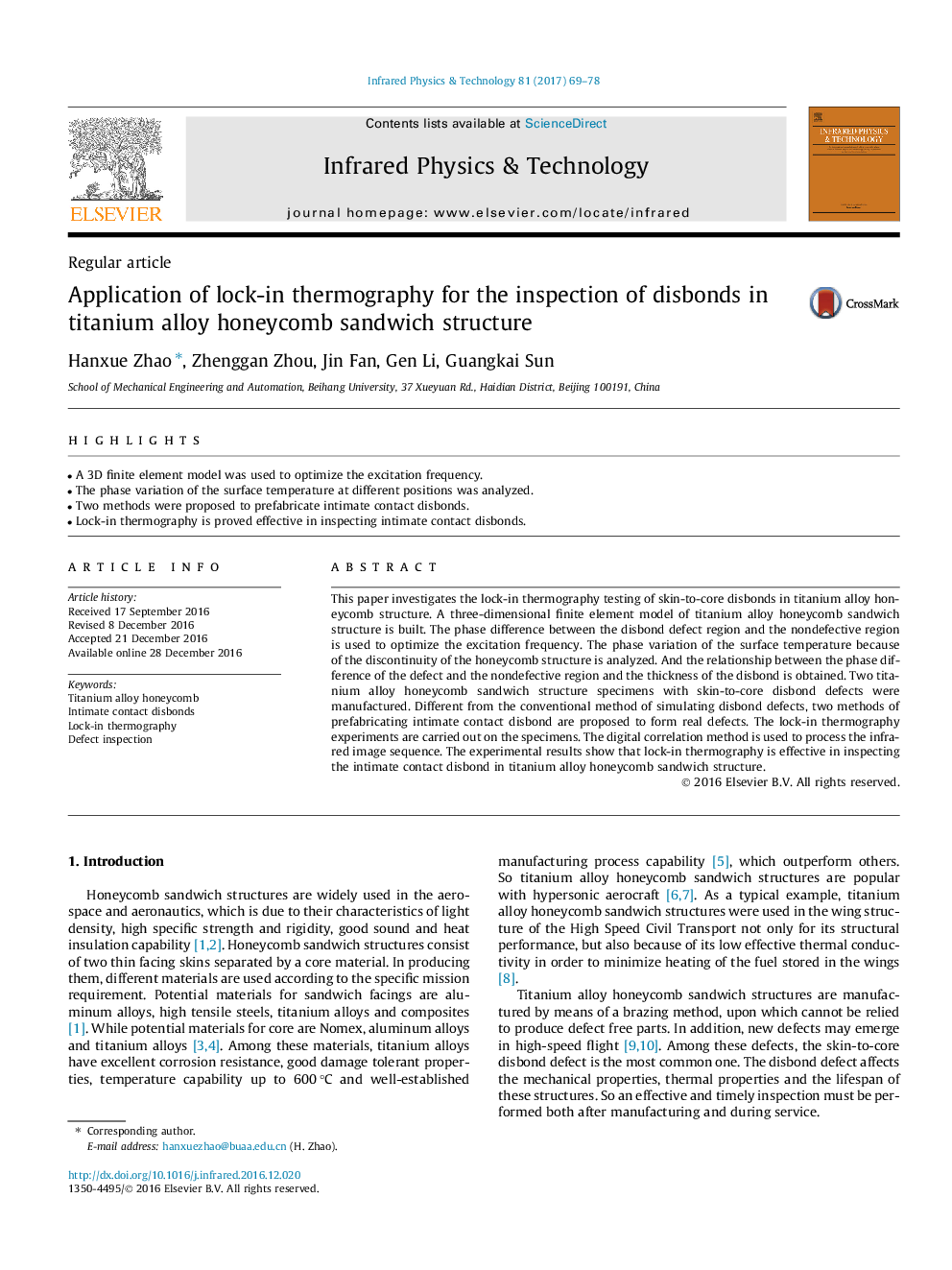| کد مقاله | کد نشریه | سال انتشار | مقاله انگلیسی | نسخه تمام متن |
|---|---|---|---|---|
| 5488677 | 1524105 | 2017 | 10 صفحه PDF | دانلود رایگان |
عنوان انگلیسی مقاله ISI
Application of lock-in thermography for the inspection of disbonds in titanium alloy honeycomb sandwich structure
ترجمه فارسی عنوان
استفاده از ترموگرافی قفل برای بازرسی از ناپیوسته در ساختار ساندویچ لانه زنبوری آلیاژ تیتانیوم
دانلود مقاله + سفارش ترجمه
دانلود مقاله ISI انگلیسی
رایگان برای ایرانیان
ترجمه چکیده
در این مقاله، تست ترموگرافی قفل در محیط سلولزی آهکی تیتانیوم از جدایه های پوستی به هسته مورد بررسی قرار گرفته است. مدل سه بعدی عنصر محدودی از ساختار ساندویچ لانه زنبوری تیتانیوم ساخته شده است. تفاوت فاز بین ناحیه نقص بی اختیاری و ناحیه ناپایدار برای بهینه سازی فرکانس تحریک استفاده می شود. تغییرات فاز دمای سطح به علت انقباض ساختار لانه زنبوری، تجزیه و تحلیل می شود. و رابطه بین تفاوت فاز نقص و ناحیه غیرفعال و ضخامت بی اختیاری به دست آمده است. دو نمونه ساختار ساندویچ لانه زنبوری با آلیاژ تیتانیوم با نقصهای ناشی از پوست به هسته تولید شده است. از روش متداول شبیه سازی نقص بی اختیاری متفاوت است، دو روش پیش ساز ساختن اختلال تماس صمیمی به منظور ایجاد نقص های واقعی ارائه می شود. آزمایشات قفل در ترموگرافی بر روی نمونه انجام می شود. روش همبستگی دیجیتال برای پردازش توالی تصویر مادون قرمز استفاده می شود. نتایج تجربی نشان می دهد که ترموگرافی قفل در بازرسی اتصالات صمیمی در ساختار ساندویچ لانه زنبوری آلیاژ تیتانیوم موثر است.
موضوعات مرتبط
مهندسی و علوم پایه
فیزیک و نجوم
فیزیک اتمی و مولکولی و اپتیک
چکیده انگلیسی
This paper investigates the lock-in thermography testing of skin-to-core disbonds in titanium alloy honeycomb structure. A three-dimensional finite element model of titanium alloy honeycomb sandwich structure is built. The phase difference between the disbond defect region and the nondefective region is used to optimize the excitation frequency. The phase variation of the surface temperature because of the discontinuity of the honeycomb structure is analyzed. And the relationship between the phase difference of the defect and the nondefective region and the thickness of the disbond is obtained. Two titanium alloy honeycomb sandwich structure specimens with skin-to-core disbond defects were manufactured. Different from the conventional method of simulating disbond defects, two methods of prefabricating intimate contact disbond are proposed to form real defects. The lock-in thermography experiments are carried out on the specimens. The digital correlation method is used to process the infrared image sequence. The experimental results show that lock-in thermography is effective in inspecting the intimate contact disbond in titanium alloy honeycomb sandwich structure.
ناشر
Database: Elsevier - ScienceDirect (ساینس دایرکت)
Journal: Infrared Physics & Technology - Volume 81, March 2017, Pages 69-78
Journal: Infrared Physics & Technology - Volume 81, March 2017, Pages 69-78
نویسندگان
Hanxue Zhao, Zhenggan Zhou, Jin Fan, Gen Li, Guangkai Sun,
